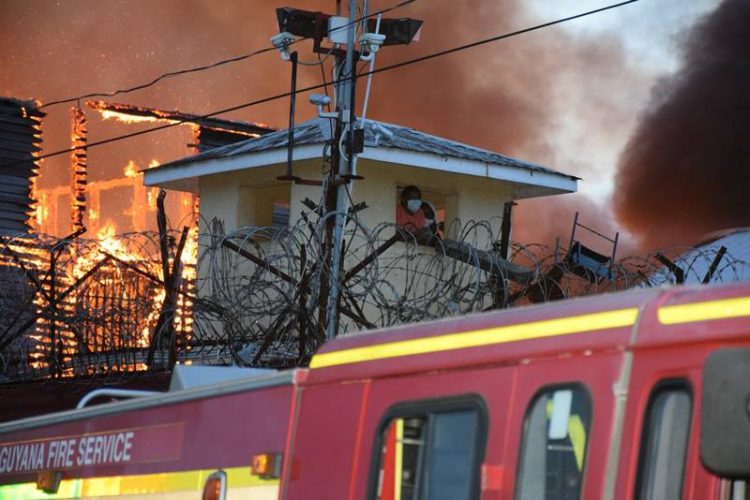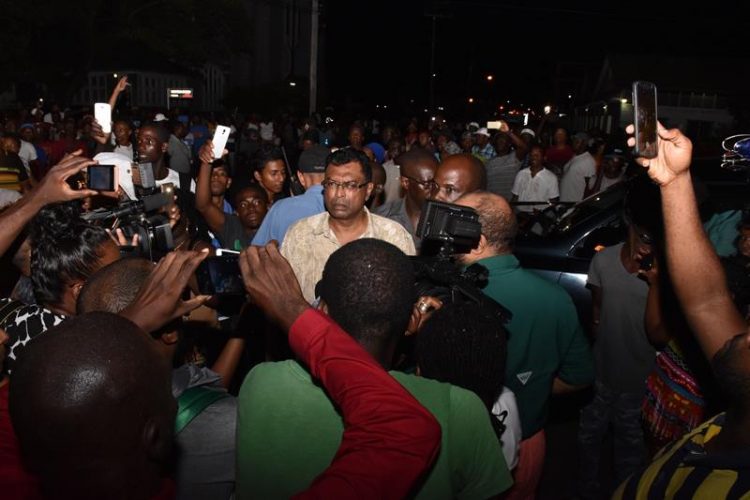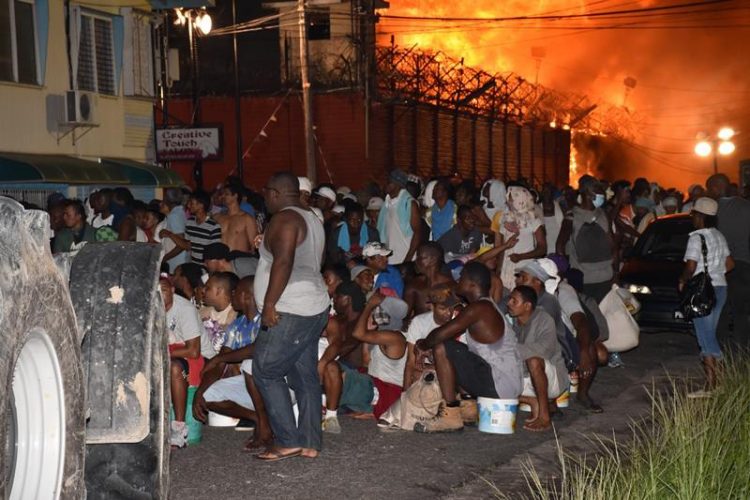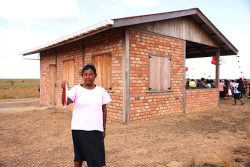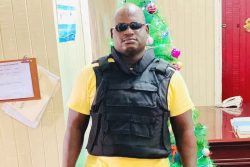Resistance by inmates to help offered by warders and firefighters during the Camp Street prison riot and fire on Sunday has been seen as a major factor in the destruction of the state’s main penitentiary.
“You have 1018 souls to account for, what is your priority? Your priority is to ensure the fire doesn’t jump outside the walls of the prison, and secondly, to ensure everybody exits the prison safely. Intersperse that now with personnel…going about their duties, under constant attacks with bricks as big as my head and other obstacles being thrown at them …that were commandeered by those prisoners,” Fire Chief Marlon Gentle said on Sunday.
Stabroek News arrived on the scene just after 4pm and there were no fire tenders in attendance as yet. One arrived shortly after and parked at the corner of D’Urban and John streets. Two others came later; one stopped at the intersection of Camp and Bent streets, while the other was stationed at Bent and John streets. Around 6pm another fire tender came and took up a position at D’Urban and Camp streets. Noise coming from rowdy prisoners could be heard, and rocks, pieces of wood and other objects were being hurled over the fence that faces D’Urban and John streets. It is unclear where the large rocks came from, but the wood seemed to have been from parts of the said prison’s wooden structure.
The prisoners wreaked havoc as they threw bricks at officers and firefighters, and created much disturbance as prison officials sought to enter the compound through the main entrance on Camp Street to begin evacuations.
They would have to wait for another hour until back up from the Joint Services arrived in order to start the evacuation. In the meantime, obstacles rained over the fence. It is believed that the prisoners gathered the rocks from the compound and hurled them at the firefighters.
The fire service sprang into action first at the corner of John and D’Urban streets when the fire started in the capital block. They then moved to Bent Street where they battled a fire set to the north eastern building, which was reportedly the Chapel. Within a matter of minutes, the entire building went up in flames as the fire service was unable to contain the fire and prevent it from spreading to the adjacent building, which is reportedly the infirmary where prisoners, including some who are unable to walk, were kept.
But Gentle said that four fires started simultaneously. “When they (the fire service) got there, there were four different fires at four different points at the prisons, which immediately tells you that it is not a normal situation, one, and two that you have to look at other alternatives. Firefighting now is not the immediate priority but more evacuation,” he stated. Firefighters at the scene explained to this newspaper that in such a volatile situation they could only fight the blaze from the outside and had to wait on orders before entering the compound.
Head of Operations of the Guyana Police Force, former A Division Commander Clifton Hicken arrived shortly after 5pm and directed activities. He could be heard shouting that additional backup be called for and that handcuffs be brought.
Subsequently, Director of Prisons Gladwyn Samuels arrived, and was followed by an open-back vehicle bringing Guyana Defence Force (GDF) soldiers.
They too seemed to be assessing the situation before opening up the main gates. With the backup of armed police, the army and multiple vehicles (which, it was later learnt, were there to transfer the inmates), Hicken took over the evacuation of the prisoners from inside the prison to about 100 yards away, across the road to the Prison Officers Recreational Centre at Camp and Bent streets.
This was around 5:45pm, and from the outside the fire seemed uncontrollable, and spontaneous explosions could be heard, but the doors to the Camp Street main entrance were open.
Most of the prisoners collected their belongings which were stored in plastic buckets that once held margarine. “Grab your things and move with speed,” yelled a male on Camp Street.
Some of the prisoners volunteered to assist the warders with the removal of documents, and worked tirelessly, moving back and forth, while the prison was ablaze.
A decision was then made to restrict all entry to the interior of the prisons as the heat became unbearable.
By this time a Guyana Defence Force helicopter was constantly circling the prison.
Minister of Public Security Khemraj Ramjattan turned up after 7pm, and shortly after exiting his vehicle and making his way over to speak to the prisoners, he had to be whisked away since plastic corks and a few bottles were being pelted in his direction. The inmates also were screaming, “We don’t want talk to nobody.”
The transfer of the prisoners to Lusignan continued sometime into the wee hours of Monday morning.

